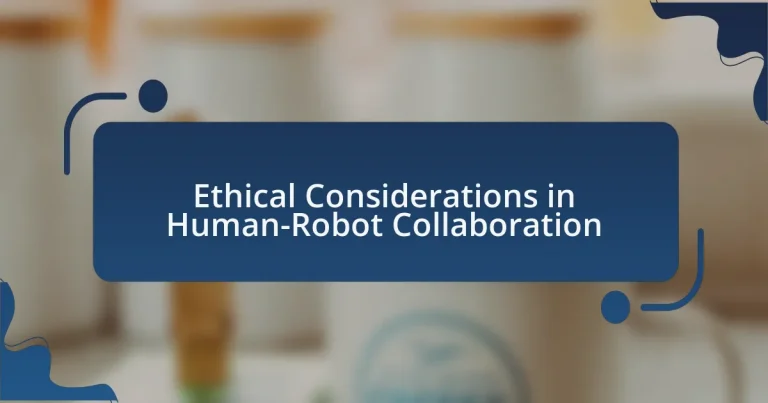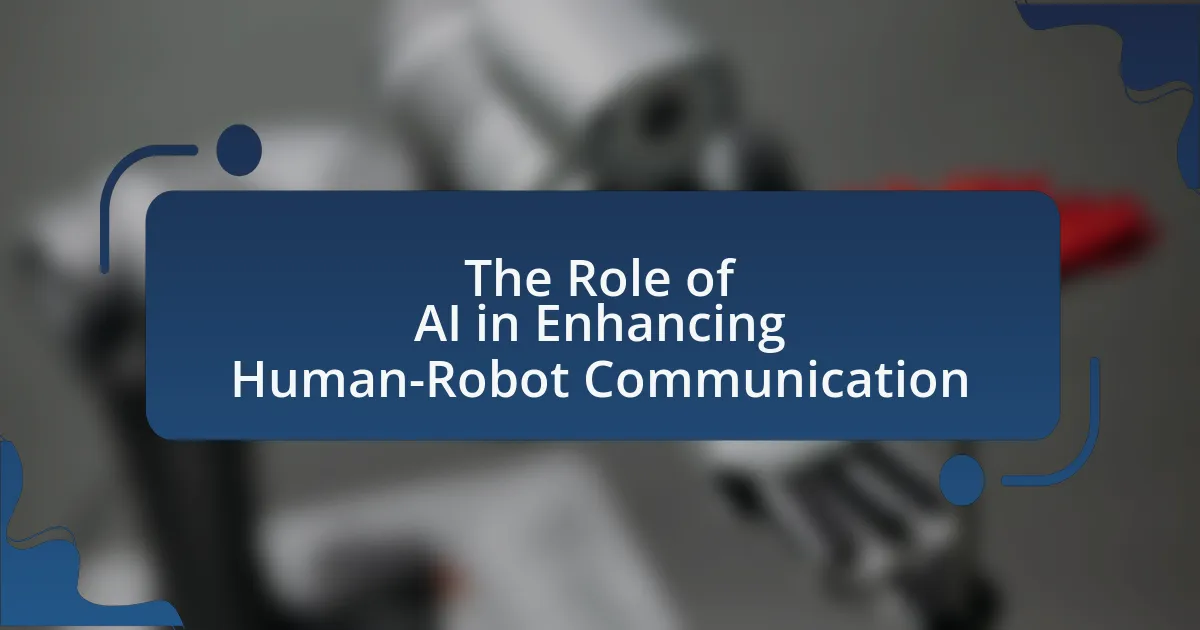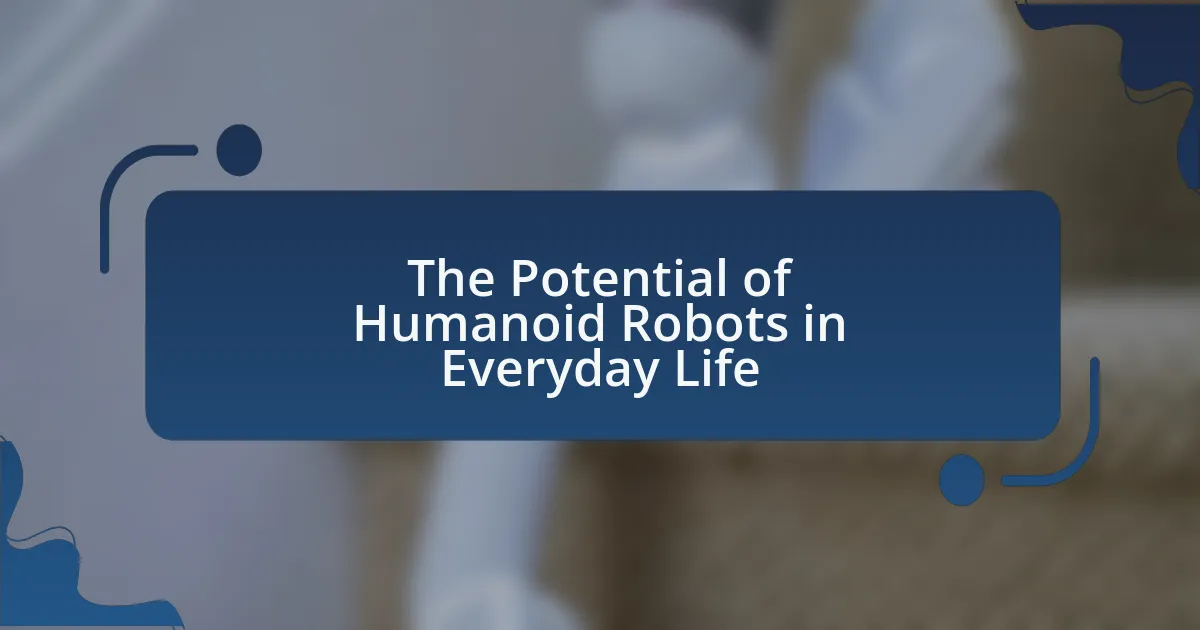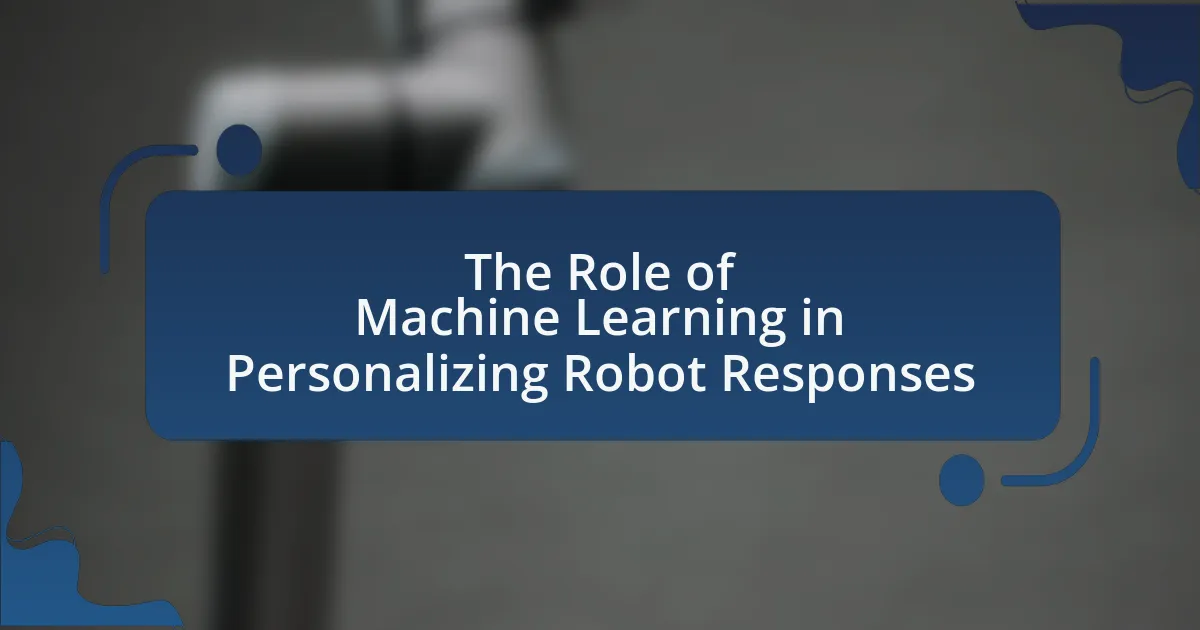The article focuses on ethical considerations in human-robot collaboration, addressing critical issues such as safety, accountability, privacy, and employment impact. It emphasizes the importance of ethical guidelines to ensure that interactions between humans and robots respect human rights and dignity, fostering trust and preventing harm. The article explores various ethical dilemmas, frameworks, and theories relevant to robotics, highlighting the role of cultural perspectives and public perception in shaping ethical standards. Additionally, it discusses best practices for organizations to promote ethical practices and the implications of neglecting ethics in robotics, ultimately underscoring the need for ongoing dialogue and adaptation of ethical frameworks in response to technological advancements.
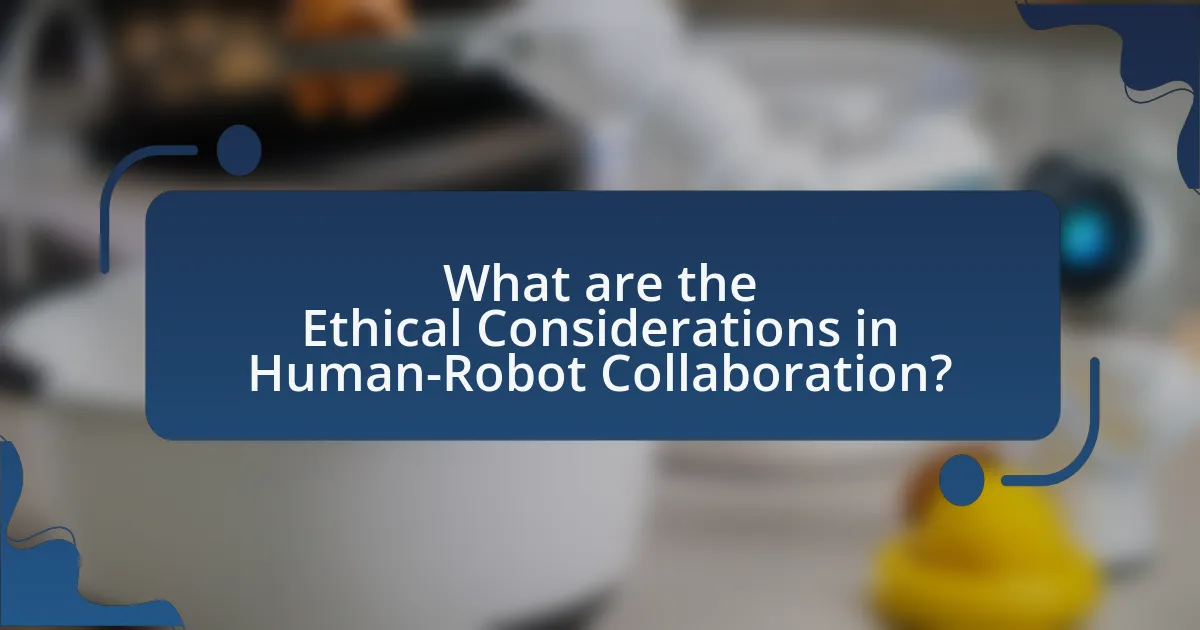
What are the Ethical Considerations in Human-Robot Collaboration?
Ethical considerations in human-robot collaboration include issues of safety, accountability, privacy, and the impact on employment. Safety is paramount, as robots must operate without causing harm to humans, necessitating rigorous testing and adherence to safety standards. Accountability arises when determining who is responsible for a robot’s actions, especially in scenarios involving accidents or errors; this often leads to discussions about liability and legal frameworks. Privacy concerns emerge from the data collection capabilities of robots, which can infringe on individual privacy rights if not managed properly. Lastly, the impact on employment is significant, as automation may displace jobs, raising ethical questions about workforce displacement and the need for retraining programs. These considerations are critical for developing guidelines that ensure responsible integration of robots into society.
Why is ethics important in human-robot collaboration?
Ethics is important in human-robot collaboration because it ensures that interactions between humans and robots are conducted in a manner that respects human rights, safety, and dignity. Ethical guidelines help to establish trust, promote accountability, and prevent harm in scenarios where robots assist or replace human roles. For instance, the IEEE Global Initiative on Ethics of Autonomous and Intelligent Systems emphasizes the need for ethical considerations to guide the design and deployment of robots, ensuring they align with societal values and norms. This framework is crucial as it addresses potential issues such as bias in algorithms, privacy concerns, and the implications of automation on employment, thereby fostering a responsible integration of robotic systems into everyday life.
What ethical dilemmas arise in human-robot interactions?
Ethical dilemmas in human-robot interactions include issues of autonomy, accountability, and privacy. Autonomy concerns arise when robots make decisions that affect human lives, leading to questions about the extent to which humans should relinquish control. Accountability issues emerge when determining who is responsible for a robot’s actions, particularly in cases of harm or malfunction. Privacy dilemmas occur when robots collect and process personal data, raising concerns about consent and data security. These dilemmas are critical as they challenge existing ethical frameworks and necessitate new guidelines for safe and responsible human-robot collaboration.
How do ethical considerations impact trust in robots?
Ethical considerations significantly impact trust in robots by influencing users’ perceptions of safety, reliability, and moral alignment. When robots are designed with ethical guidelines that prioritize user welfare, transparency, and accountability, individuals are more likely to trust their actions and decisions. For instance, research indicates that robots programmed to adhere to ethical standards, such as the Asimov’s Laws of Robotics, enhance user confidence in their reliability and decision-making processes. Furthermore, studies show that ethical concerns, such as data privacy and bias in algorithms, can erode trust if not adequately addressed, as users may fear misuse or unfair treatment. Thus, ethical considerations serve as a foundational element in fostering trust between humans and robots, directly affecting the effectiveness of human-robot collaboration.
What frameworks exist for addressing ethical issues in robotics?
Several frameworks exist for addressing ethical issues in robotics, including the IEEE Global Initiative on Ethics of Autonomous and Intelligent Systems, the Asilomar AI Principles, and the EU’s Ethics Guidelines for Trustworthy AI. The IEEE framework provides a comprehensive set of guidelines aimed at ensuring that technology is aligned with human values and ethical principles. The Asilomar AI Principles focus on the safe and beneficial development of AI technologies, emphasizing transparency and accountability. The EU’s guidelines outline key requirements for AI systems, such as human oversight and robustness, to promote ethical practices in robotics. These frameworks collectively aim to guide the responsible development and deployment of robotic systems, ensuring they operate within ethical boundaries.
How do different ethical theories apply to human-robot collaboration?
Different ethical theories, such as utilitarianism, deontology, and virtue ethics, apply to human-robot collaboration by providing frameworks for evaluating the moral implications of interactions between humans and robots. Utilitarianism assesses the outcomes of collaboration, emphasizing actions that maximize overall happiness and minimize harm; for instance, robots in healthcare can improve patient outcomes, thus aligning with utilitarian principles. Deontology focuses on adherence to rules and duties, suggesting that robots must respect human rights and autonomy, such as ensuring that robots do not infringe on privacy or make decisions without human consent. Virtue ethics emphasizes the character and intentions of the individuals involved, advocating for the development of robots that promote human virtues like trustworthiness and empathy. These theories collectively guide the ethical design, deployment, and regulation of robots in various sectors, ensuring that human-robot collaboration is beneficial and morally sound.
What role do guidelines and regulations play in ethical robotics?
Guidelines and regulations are essential in ethical robotics as they establish standards for safety, accountability, and fairness in robotic systems. These frameworks help ensure that robots operate within ethical boundaries, protecting human rights and promoting trust in technology. For instance, the IEEE Global Initiative on Ethics of Autonomous and Intelligent Systems provides a comprehensive set of guidelines aimed at fostering ethical design and deployment of robotics. Such regulations are crucial in addressing potential risks, including bias in algorithms and the implications of automation on employment, thereby guiding developers and organizations in creating responsible robotic solutions.
How do cultural perspectives influence ethical considerations?
Cultural perspectives significantly influence ethical considerations by shaping individuals’ values, beliefs, and norms regarding right and wrong. For instance, collectivist cultures often prioritize community welfare and harmony, leading to ethical frameworks that emphasize group consensus and social responsibility. In contrast, individualistic cultures may focus on personal autonomy and rights, resulting in ethical considerations that prioritize individual freedoms and self-expression. Research by Hofstede (1980) highlights these cultural dimensions, illustrating how varying cultural contexts can lead to different ethical interpretations and decision-making processes in scenarios like human-robot collaboration. This divergence in ethical perspectives necessitates a nuanced understanding of cultural influences to ensure that ethical guidelines in technology development are inclusive and culturally sensitive.
What are the variations in ethical views across different cultures?
Variations in ethical views across different cultures significantly influence perspectives on human-robot collaboration. For instance, Western cultures often emphasize individualism and autonomy, leading to ethical frameworks that prioritize personal rights and freedoms in technology use. In contrast, many Eastern cultures, such as those influenced by Confucianism, focus on collectivism and harmony, which may prioritize societal benefits and relationships over individual rights. Research by Hofstede (1980) highlights these cultural dimensions, showing that cultures with high collectivism may view robots as extensions of community rather than individual tools. This cultural context shapes how ethical considerations are approached in human-robot interactions, affecting trust, responsibility, and the perceived role of robots in society.
How can cultural differences affect human-robot collaboration?
Cultural differences can significantly affect human-robot collaboration by influencing communication styles, trust levels, and expectations of robot behavior. For instance, cultures that prioritize collectivism may expect robots to work harmoniously within teams, while individualistic cultures might focus on personal efficiency and autonomy. Research by Hofstede (1980) highlights how cultural dimensions, such as power distance and uncertainty avoidance, shape interactions with technology, including robots. In high power distance cultures, individuals may defer to robots as authoritative figures, whereas in low power distance cultures, users may expect robots to be more egalitarian and collaborative. These variations can lead to misunderstandings and reduced effectiveness in human-robot teamwork if not properly addressed.
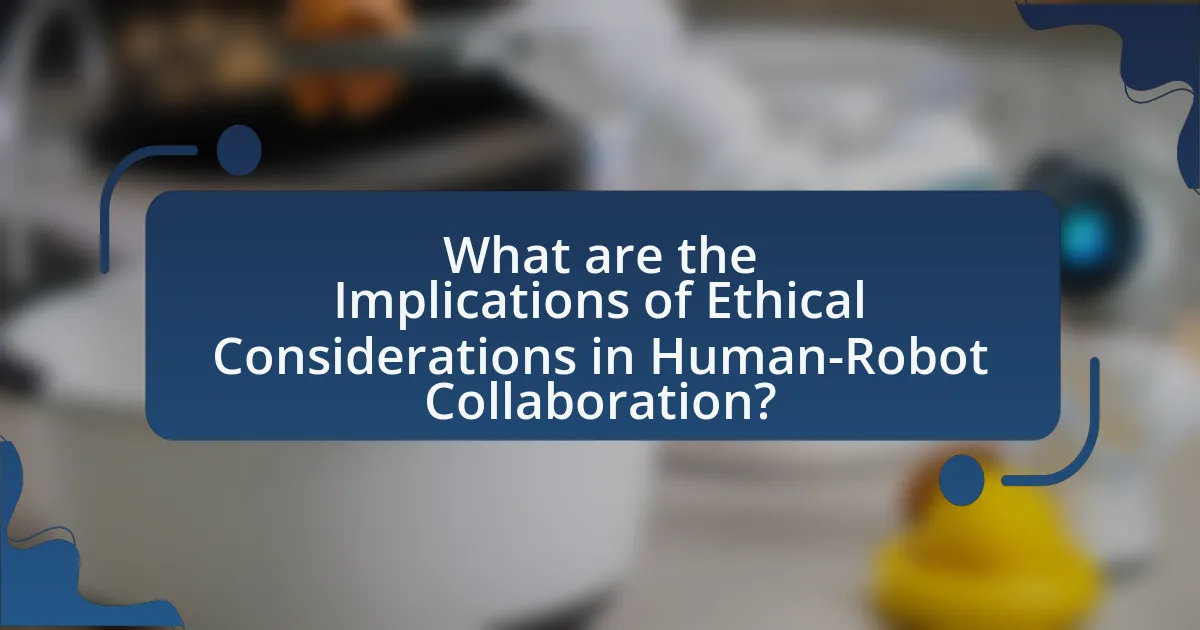
What are the Implications of Ethical Considerations in Human-Robot Collaboration?
The implications of ethical considerations in human-robot collaboration include the need for accountability, transparency, and the protection of human dignity. These ethical dimensions are crucial as they influence the design and deployment of robots in various sectors, ensuring that human values are upheld. For instance, the integration of robots in healthcare raises questions about patient privacy and consent, necessitating clear guidelines to protect sensitive information. Additionally, ethical frameworks can guide the development of autonomous systems, ensuring that they operate within acceptable moral boundaries, thereby fostering trust between humans and robots. Research indicates that addressing these ethical considerations can enhance collaboration effectiveness and mitigate risks associated with robotic systems, as highlighted in studies such as “Ethics of Human-Robot Interaction” by Lin et al. (2011), which emphasizes the importance of ethical guidelines in technology deployment.
How do ethical considerations affect the design of robots?
Ethical considerations significantly influence the design of robots by ensuring that they operate within moral frameworks that prioritize human safety, privacy, and autonomy. Designers incorporate ethical guidelines to prevent harm, such as implementing fail-safes and ensuring transparency in decision-making processes. For instance, the IEEE Global Initiative on Ethics of Autonomous and Intelligent Systems emphasizes the importance of aligning robotic behavior with human values, which includes accountability and fairness. This approach not only fosters trust between humans and robots but also addresses societal concerns about the implications of automation, such as job displacement and surveillance.
What features can enhance ethical compliance in robotic systems?
Features that can enhance ethical compliance in robotic systems include transparency, accountability, and adherence to ethical guidelines. Transparency allows users to understand the decision-making processes of robots, fostering trust and enabling informed consent. Accountability ensures that there are mechanisms in place to hold developers and operators responsible for the actions of robotic systems, which is crucial for ethical governance. Adherence to established ethical guidelines, such as those proposed by organizations like the IEEE and ISO, provides a framework for ethical behavior in robotic design and operation. These features collectively contribute to a robust ethical framework that guides human-robot collaboration.
How can designers incorporate ethical guidelines into robotics?
Designers can incorporate ethical guidelines into robotics by integrating principles such as transparency, accountability, and user-centered design throughout the development process. Transparency ensures that users understand how robots make decisions, which can be achieved by providing clear information about algorithms and data usage. Accountability involves establishing clear lines of responsibility for the actions of robots, which can be reinforced through regulatory frameworks and ethical review boards. User-centered design focuses on the needs and values of users, ensuring that robots are designed to enhance human well-being and respect privacy. Research by the IEEE Global Initiative on Ethics of Autonomous and Intelligent Systems emphasizes the importance of these principles, advocating for ethical considerations to be embedded in the design and deployment of robotic systems.
What are the potential consequences of neglecting ethics in robotics?
Neglecting ethics in robotics can lead to significant negative consequences, including harm to individuals, societal distrust, and legal repercussions. For instance, without ethical guidelines, robots may be programmed to prioritize efficiency over human safety, resulting in accidents or injuries, as seen in cases where autonomous vehicles have malfunctioned. Additionally, the absence of ethical standards can foster public skepticism towards robotic technologies, hindering their acceptance and integration into society. This distrust can be evidenced by surveys indicating that a majority of people express concerns about the safety and reliability of robots in critical roles, such as healthcare and transportation. Furthermore, neglecting ethics can result in legal challenges, as companies may face lawsuits for negligence or violations of privacy rights, particularly if robots collect and misuse personal data. These consequences underscore the importance of establishing ethical frameworks to guide the development and deployment of robotic systems.
How can unethical practices lead to public backlash against robots?
Unethical practices can lead to public backlash against robots by eroding trust and raising concerns about safety and fairness. When robots are involved in unethical behaviors, such as biased decision-making or invasion of privacy, public perception shifts negatively, resulting in fear and resistance to their integration. For instance, incidents where algorithms exhibit racial bias in hiring processes have sparked outrage, demonstrating how unethical outcomes can provoke widespread criticism and calls for regulation. This backlash can manifest in protests, demands for stricter oversight, and a reluctance to adopt robotic technologies, ultimately hindering advancements in human-robot collaboration.
What risks do unethical robots pose to society?
Unethical robots pose significant risks to society, including the potential for harm to individuals, erosion of trust in technology, and exacerbation of social inequalities. These robots may be programmed to act in ways that prioritize efficiency over ethical considerations, leading to decisions that can endanger human lives, such as in autonomous vehicles that fail to prioritize pedestrian safety. Furthermore, unethical robots can undermine public trust in technology, as seen in cases where algorithms exhibit bias, resulting in discriminatory outcomes in areas like hiring or law enforcement. This erosion of trust can hinder the adoption of beneficial technologies. Additionally, the deployment of unethical robots can deepen existing social inequalities, as marginalized groups may be disproportionately affected by biased algorithms or lack access to advanced technologies. These risks highlight the critical need for ethical guidelines in the development and deployment of robotic systems.
How can organizations ensure ethical practices in human-robot collaboration?
Organizations can ensure ethical practices in human-robot collaboration by establishing clear guidelines and frameworks that prioritize transparency, accountability, and fairness. Implementing ethical guidelines, such as those proposed by the IEEE Global Initiative on Ethics of Autonomous and Intelligent Systems, helps organizations define acceptable behaviors and responsibilities for both humans and robots. Additionally, conducting regular assessments and audits of robotic systems can identify potential ethical issues, ensuring compliance with established standards. Engaging stakeholders, including employees and ethicists, in the design and deployment processes fosters a culture of ethical awareness and responsibility.
What best practices should organizations adopt for ethical robotics?
Organizations should adopt transparency, accountability, and inclusivity as best practices for ethical robotics. Transparency involves clearly communicating the capabilities and limitations of robotic systems to users and stakeholders, ensuring informed decision-making. Accountability requires establishing clear guidelines for responsibility in the event of robotic failures or ethical breaches, which can be supported by frameworks like the IEEE Global Initiative on Ethics of Autonomous and Intelligent Systems. Inclusivity emphasizes the importance of involving diverse stakeholders in the design and deployment processes, which can enhance the ethical considerations and societal acceptance of robotic technologies. These practices are essential for fostering trust and ensuring that robotics serve the public good.
How can training and education promote ethical awareness in robotics?
Training and education can promote ethical awareness in robotics by integrating ethical frameworks and decision-making processes into the curriculum for engineers and developers. This approach ensures that individuals involved in robotics are equipped with the knowledge to recognize and address ethical dilemmas, such as bias in algorithms or the implications of automation on employment. Research indicates that programs emphasizing ethics, like the IEEE’s Ethically Aligned Design, provide guidelines that help practitioners understand the societal impacts of their work, fostering a culture of responsibility and accountability in robotics development.
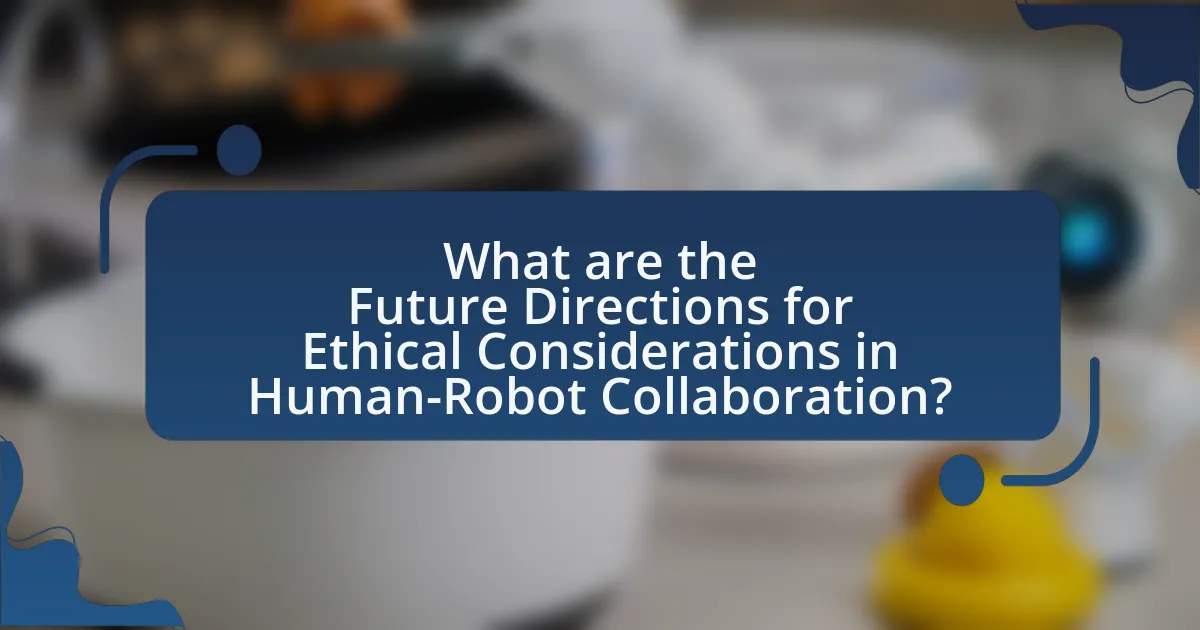
What are the Future Directions for Ethical Considerations in Human-Robot Collaboration?
Future directions for ethical considerations in human-robot collaboration include the development of frameworks that prioritize transparency, accountability, and fairness in robotic systems. As robots increasingly participate in decision-making processes, ethical guidelines must evolve to address issues such as bias in algorithms, the implications of autonomy, and the protection of human rights. Research indicates that incorporating diverse stakeholder perspectives can enhance ethical standards, as seen in studies like “Ethics of AI and Robotics” by the European Commission, which emphasizes the need for inclusive dialogue in shaping policies. Additionally, ongoing assessments of the societal impact of robots will be crucial in ensuring that ethical considerations remain relevant and effective in guiding human-robot interactions.
How will advancements in technology shape ethical considerations?
Advancements in technology will significantly shape ethical considerations by introducing complex dilemmas regarding autonomy, privacy, and accountability. As robots and AI systems become more integrated into daily life, ethical frameworks must evolve to address issues such as decision-making authority and the potential for bias in algorithms. For instance, the deployment of autonomous vehicles raises questions about liability in accidents, necessitating clear guidelines on accountability. Furthermore, the increasing use of surveillance technologies in public spaces challenges existing norms around privacy, requiring new ethical standards to protect individual rights. These developments underscore the need for ongoing dialogue among technologists, ethicists, and policymakers to ensure that ethical considerations keep pace with technological progress.
What emerging technologies pose new ethical challenges in robotics?
Emerging technologies such as artificial intelligence, machine learning, and autonomous systems pose new ethical challenges in robotics. These technologies enable robots to make decisions and perform tasks independently, raising concerns about accountability, bias, and the potential for misuse. For instance, AI algorithms can inadvertently perpetuate biases present in training data, leading to unfair treatment in applications like hiring or law enforcement. Additionally, the deployment of autonomous systems in military contexts raises questions about the morality of delegating life-and-death decisions to machines. The rapid advancement of these technologies necessitates ongoing ethical scrutiny to ensure responsible development and deployment in human-robot collaboration.
How can ethical frameworks evolve with technological advancements?
Ethical frameworks can evolve with technological advancements by integrating new ethical considerations that arise from emerging technologies. As robots and AI systems become more prevalent in society, ethical frameworks must adapt to address issues such as privacy, accountability, and the impact of automation on employment. For instance, the introduction of autonomous vehicles has prompted discussions about liability in accidents, necessitating updates to existing legal and ethical standards. Research by the IEEE Global Initiative on Ethics of Autonomous and Intelligent Systems emphasizes the need for continuous dialogue among technologists, ethicists, and policymakers to ensure that ethical guidelines remain relevant and effective in the face of rapid technological change.
What role will public perception play in the future of ethical robotics?
Public perception will significantly influence the future of ethical robotics by shaping societal norms and acceptance of robotic technologies. As public attitudes evolve, they will dictate the ethical frameworks and regulations that govern robot design and deployment. For instance, surveys indicate that 70% of people are concerned about privacy issues related to robots, which highlights the need for ethical guidelines that address these concerns. Furthermore, positive public perception can drive investment and innovation in ethical robotics, while negative perceptions may lead to resistance and regulatory hurdles. Thus, understanding and addressing public concerns is essential for the successful integration of ethical robotics into society.
How can public engagement influence ethical standards in robotics?
Public engagement can significantly influence ethical standards in robotics by fostering dialogue between stakeholders, including developers, users, and the general public. This interaction allows for diverse perspectives to be considered, ensuring that ethical guidelines reflect societal values and concerns. For instance, initiatives like public consultations and workshops have been shown to identify potential ethical dilemmas, such as privacy issues and job displacement, which can then inform the development of more robust ethical frameworks. Research conducted by the European Commission in 2017 highlighted that involving citizens in discussions about robotics can lead to more accepted and effective ethical standards, as these standards are shaped by the collective input of those affected by robotic technologies.
What strategies can be employed to improve public trust in robots?
To improve public trust in robots, transparency in their operations and decision-making processes is essential. By providing clear information about how robots function, including their limitations and capabilities, users can develop a better understanding and confidence in their use. Research indicates that when users are informed about the algorithms and data that guide robotic behavior, trust levels increase significantly. For instance, a study published in the journal “Human-Computer Interaction” by Lee et al. (2018) found that transparency in robotic systems led to a 30% increase in user trust. Additionally, involving the public in the design and testing phases of robotic systems can foster a sense of ownership and acceptance, further enhancing trust.
What practical steps can be taken to promote ethical human-robot collaboration?
To promote ethical human-robot collaboration, organizations should implement clear ethical guidelines and frameworks that govern the design and deployment of robots. These guidelines should include principles such as transparency, accountability, and respect for human autonomy. For instance, the IEEE Global Initiative on Ethics of Autonomous and Intelligent Systems provides a comprehensive framework that emphasizes the importance of ethical considerations in technology development. Additionally, involving diverse stakeholders in the design process, including ethicists, engineers, and end-users, ensures that multiple perspectives are considered, which can lead to more ethically sound outcomes. Regular training and education on ethical practices for developers and users of robotic systems can further enhance understanding and adherence to these principles.
What guidelines should be followed for ethical robot deployment?
Ethical robot deployment should adhere to guidelines that prioritize safety, transparency, accountability, and respect for human rights. Safety guidelines ensure that robots operate without causing harm to humans or the environment, as evidenced by the IEEE’s Ethically Aligned Design framework, which emphasizes risk assessment and mitigation strategies. Transparency involves clear communication about a robot’s capabilities and limitations, allowing users to make informed decisions; this is supported by studies showing that user trust increases with transparency. Accountability requires establishing responsibility for a robot’s actions, which can be reinforced through regulatory frameworks that define liability in case of malfunctions or misuse. Lastly, respecting human rights means ensuring that robots do not infringe on privacy or autonomy, aligning with the principles outlined in the Universal Declaration of Human Rights. These guidelines collectively foster ethical practices in human-robot collaboration.
How can stakeholders collaborate to enhance ethical practices in robotics?
Stakeholders can collaborate to enhance ethical practices in robotics by establishing interdisciplinary frameworks that include developers, ethicists, policymakers, and users. This collaboration can lead to the creation of comprehensive guidelines and standards that address ethical concerns such as safety, privacy, and accountability. For instance, the IEEE Global Initiative on Ethics of Autonomous and Intelligent Systems has developed a set of ethical guidelines that emphasize the importance of stakeholder engagement in the design and deployment of robotic systems. By involving diverse perspectives, stakeholders can ensure that ethical considerations are integrated throughout the lifecycle of robotics, from conception to implementation.
